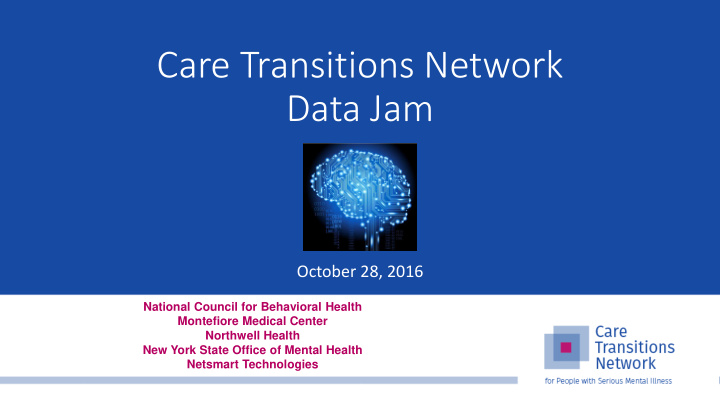



Care Transitions Network Data Jam October 28, 2016 National Council for Behavioral Health Montefiore Medical Center Northwell Health New York State Office of Mental Health Netsmart Technologies
Erica Van De Wal Anni Kramer Medical Informatics Project Director PSYCKES Implementation Director, New York State Office of Mental Bureau of Evidence Based Services Health and Implementation Science Erica.VanDeWal@omh.ny.gov New York State Office of Mental Health Anni.Kramer@omh.ny.gov Kate Davidson, LCSW Elizabeth Arend, MPH Clinical Advisor Quality Improvement Advisor National Council for Behavioral National Council for Behavioral Health Health KateD@TheNationalCouncil.org ElizabethA@TheNationalCouncil.org
CMS Change Package: Primary and Secondary Drivers Patient and Family- 1.1 Patient & family engagement Centered Care 1.2 Team-based relationships Design 1.3 Population management 1.4 Practice as a community partner 1.5 Coordinated care delivery 1.6 Organized, evidence-based care 1.7 Enhanced access Continuous, Data- 2.1 Engaged and committed leadership Driven Quality 2.2 QI strategy supporting a culture of quality and safety Improvement 2.3 Transparent measurement and monitoring 2.4 Optimal use of HIT Sustainable 3.1 Strategic use of practice revenue Business 3.2 Staff vitality and joy in work Operations 3.3 Capability to analyze and document value 3.4 Efficiency of operation
Netsmart Care Manager • Derived from Medicaid claims data = no reporting required • Provides easy access to aggregate, practice-level data that can be used for analysis and decision- making o PAT scores and progress through CMS Phases of Transformation o Care Transitions Network clinical quality measure data o Costing and financial utilization data (coming soon!)
Logg gging In In • Users will gain access to the Netsmart Data Dashboards during the quarter which they enroll. • Usernames and emails will be provided to your designated point of contact for each practice within the enrolled organization. • A detailed user guidebook will be shared with all practices that highlights access and navigation of the dashboards as well as guidance on reading and analyzing your practice data.
PAT and Phases of Transformation
“Current” CQM tab
“Analysis” CQM tab
“Chart” CQM tab
“Chart” CQM tab: select measures
Using PSYCKES for Data Review • PSYCKES is a secure, HIPAA-compliant web-based platform for sharing Medicaid claims and encounter data and other state administrative data • Designed to support clinical decision-making and quality improvement • Ongoing data updates • PSYCKES can be used to review actionable client-level information to improve measure performance
Who is viewable in PSYCKES? • NYS Medicaid enrollees, currently or recently – Fee for service (FFS) claims – Managed care encounter data – Dual-eligible (Medicare/Medicaid): Medicaid data only • Behavioral Health Population, i.e., at least one of the following: – Psychiatric or substance use service, – Psychiatric or substance use diagnosis, OR – Psychotropic medication • Provides all data – general medical, behavioral health, residential
What Data Are Available in PSYCKES? • Quality Indicator Overview provides provider/system level performance on indicators developed for quality concern Promotes QI by providing lists of recipients served by provider who meet criteria for quality concerns Updated monthly, time lag varies depending on how quickly providers bill and Managed Care plans submit to DOH • Clinical Summary provides up to five years of billing data for NYS Medicaid enrollees, including FFS and managed care Medications, medical and behavioral health outpatient and inpatient services, ER, care coordination, residential, etc. Updated weekly
Quality Indicators “Flags” • PSYCKES identifies clients flagged for quality concerns to inform the treating provider and support clinical review and quality improvement • When a client has a quality flag, the provider is allowed access to that individual’s Clinical Summary • Many PSYCKES quality indicators correspond with CQM measures: Low medication adherence for people with schizophrenia Multiple concurrent antipsychotics Hospitalization and readmission rates No LDL screening for people with schizophrenia on antipsychotic medications
PSYCKES my QI Report
Select sub-indicator or summary indicator
Export list of flagged clients to PDF or Excel Click client name to view clinical summary
Export Data for Manipulation in Excel
Recipient Search: Drill Down for Data Analysis
Export results to Excel or PDF Click on client name to view clinical summary
Clinical Summary: Up to Five Years of Data
Clinical Summary: Integrated Service View
Next xt Steps • Keep an eye out for our Data Dashboard User Guide, which will provide detailed instructions on how to log in and use the dashboard • Use the Care Manager tool to track your practice’s progress on quality indicators, ask questions and test interventions to improve • Attend our monthly Data Jams and invite your colleagues!
Questions?
Upcoming Webinars MACRA in New York: CMS’s New Quality Payment Program Wednesday, November 2 nd (2-3PM) Engaging Patients in Informed Decision-Making about Long Acting Injectable Medications Wednesday, November 9 th (2-3PM)
Thank you! www.CareTransitionsNetwork.org CareTransitions@TheNationalCouncil.org The project described was supported by Funding Opportunity Number CMS-1L1-15-003 from the U.S. Department of Health & Human Services, Centers for Medicare & Medicaid Services. Disclaimer: The contents provided are solely the responsibility of the authors and do not necessarily represent the official views of HHS or any of its agencies.
Recommend
More recommend